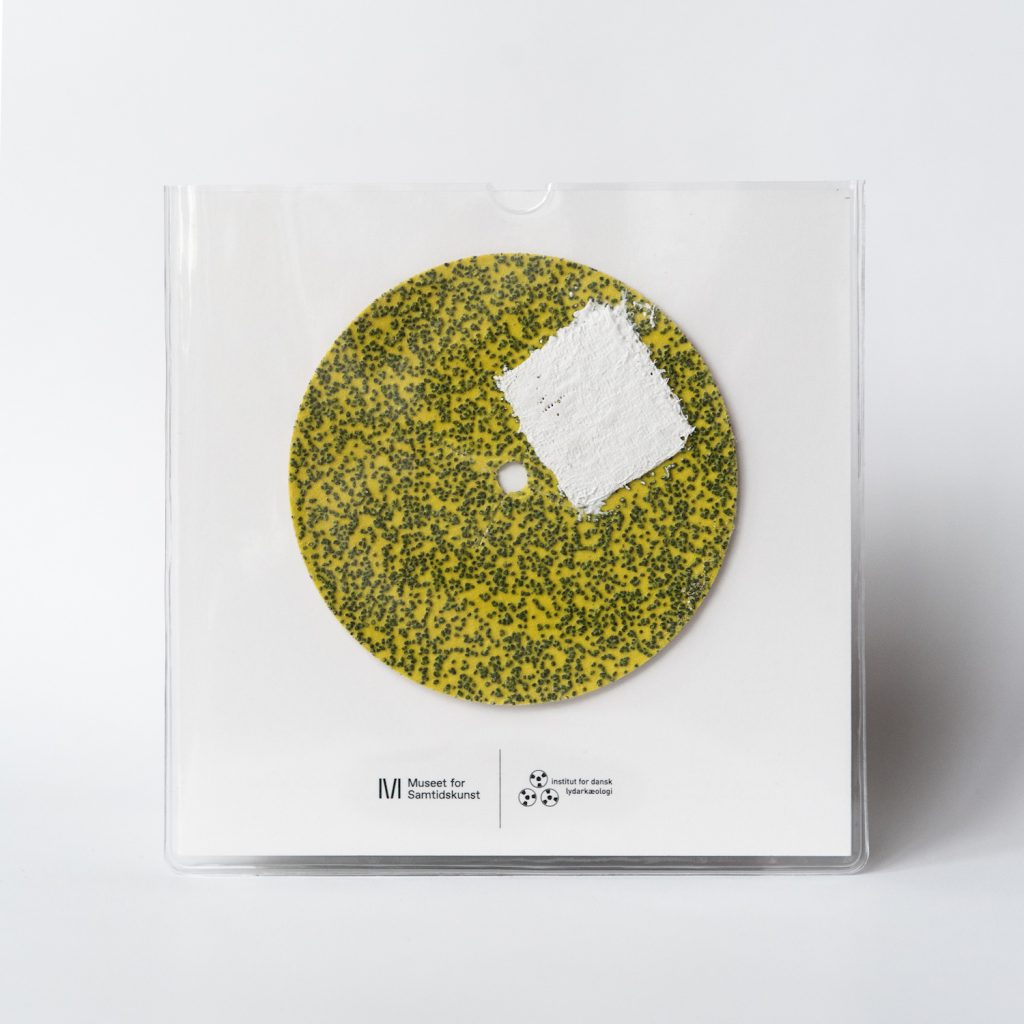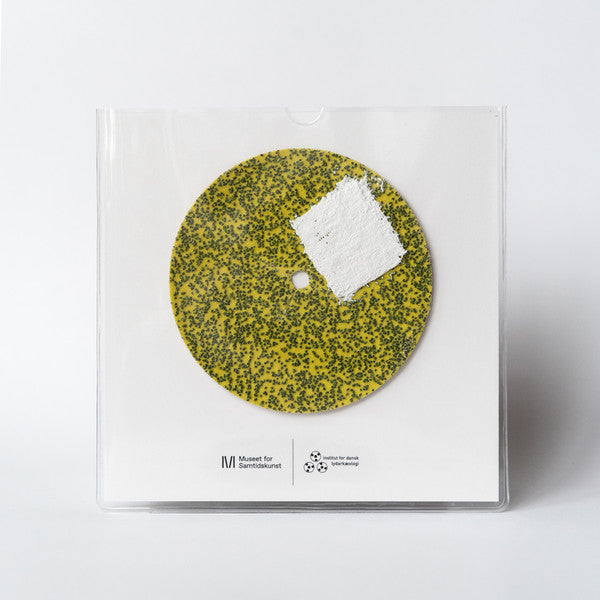1
/
of
1
HAVE, HENRIK - Architecture Piece op. 2, 1989
Institut for Dansk Lydarkaeologi
Regular price
$78.00 USD
Regular price
Sale price
$78.00 USD
Quantity
Couldn't load pickup availability
"Architecture Piece op. 2 was originally created to be part of a black cardboard box published in 1989 by the Museum of Contemporary Art in Roskilde, Denmark, thus predating the official foundation of the museum in 1991. The box was conceptualized and designed by Henrik Have himself. It was part of a fundraising strategy to meet the requirements for the museum to gain state recognition. Museum shares were issued and sold for 1,000 DKK. Each share was accompanied by one of the cardboard boxes and a graphic work, also by Henrik Have. The boxes each contained a flexi disc with a recording of a spoken word performance by Fluxus artist Alison Knowles along with loose pages of images of the baroque buildings where the museum is housed, a poster, quotes by John Cage and Hans Christian Andersen folded as leporellos, and loose printed pages of vision and strategy statements for the museum. Some but not all of the boxes included the Architecture Piece op. 2 edition by Have. The edition exists in slightly different versions with varying colors of sandpaper of different grit sizes.
The sandpaper record places itself in the tradition of anti-records" generallyrally credited back to Milan Knižáks Broken Music (1979) where a number of existing records were treated physically by painting on the surfaces, scratching with nails, sawing different records in pieces, glueing them together with other records etc. Several other sandpaper records have been published. Pete Horobins mail art work Dysart (1983) consists of a worn 7” sandpaper record in a paper sleeve with the outline of a hand and a used bandage attached. Perhaps the best known examples are the double 7” sandpaper records by Richard D. James aka Aphex Twin, released in 1994 and used in DJ sets by James himself.
The sandpaper record also echoes the famous artist book Mémoires (1959) by artists Asger Jorn and Guy Debord. The book was bound in sandpaper and meant to destroy the neighboring books it was placed next to on the shelf.
The record player covered in plaster bandage is in the collection of the Museum of Contemporary Art, as part of the installation Fibre Music (1992) by Henrik Have. The installation also includes a framed image of the record player identical to the one included in this release.
The few remaining copies of Architecture Piece op. 2 are re-released by The Institute for Danish Sound Archaeology in collaboration with the Museum of Contemporary Art." - "Architecture Piece op. 2 was originally created to be part of a black cardboard box published in 1989 by the Museum of Contemporary Art in Roskilde, Denmark, thus predating the official foundation of the museum in 1991. The box was conceptualized and designed by Henrik Have himself. It was part of a fundraising strategy to meet the requirements for the museum to gain state recognition. Museum shares were issued and sold for 1,000 DKK. Each share was accompanied by one of the cardboard boxes and a graphic work, also by Henrik Have. The boxes each contained a flexi disc with a recording of a spoken word performance by Fluxus artist Alison Knowles along with loose pages of images of the baroque buildings where the museum is housed, a poster, quotes by John Cage and Hans Christian Andersen folded as leporellos, and loose printed pages of vision and strategy statements for the museum. Some but not all of the boxes included the Architecture Piece op. 2 edition by Have. The edition exists in slightly different versions with varying colors of sandpaper of different grit sizes.
The sandpaper record places itself in the tradition of "anti-records" generallyrally credited back to Milan Knižáks Broken Music (1979) where a number of existing records were treated physically by painting on the surfaces, scratching with nails, sawing different records in pieces, glueing them together with other records etc. Several other sandpaper records have been published. Pete Horobins mail art work Dysart (1983) consists of a worn 7” sandpaper record in a paper sleeve with the outline of a hand and a used bandage attached. Perhaps the best known examples are the double 7” sandpaper records by Richard D. James aka Aphex Twin, released in 1994 and used in DJ sets by James himself.
The sandpaper record also echoes the famous artist book Mémoires (1959) by artists Asger Jorn and Guy Debord. The book was bound in sandpaper and meant to destroy the neighboring books it was placed next to on the shelf.
The record player covered in plaster bandage is in the collection of the Museum of Contemporary Art, as part of the installation Fibre Music (1992) by Henrik Have. The installation also includes a framed image of the record player identical to the one included in this release.
The few remaining copies of Architecture Piece op. 2 are re-released by The Institute for Danish Sound Archaeology in collaboration with the Museum of Contemporary Art." - Institut for Dansk Lydarkaeologi.

View full details
The sandpaper record places itself in the tradition of anti-records" generallyrally credited back to Milan Knižáks Broken Music (1979) where a number of existing records were treated physically by painting on the surfaces, scratching with nails, sawing different records in pieces, glueing them together with other records etc. Several other sandpaper records have been published. Pete Horobins mail art work Dysart (1983) consists of a worn 7” sandpaper record in a paper sleeve with the outline of a hand and a used bandage attached. Perhaps the best known examples are the double 7” sandpaper records by Richard D. James aka Aphex Twin, released in 1994 and used in DJ sets by James himself.
The sandpaper record also echoes the famous artist book Mémoires (1959) by artists Asger Jorn and Guy Debord. The book was bound in sandpaper and meant to destroy the neighboring books it was placed next to on the shelf.
The record player covered in plaster bandage is in the collection of the Museum of Contemporary Art, as part of the installation Fibre Music (1992) by Henrik Have. The installation also includes a framed image of the record player identical to the one included in this release.
The few remaining copies of Architecture Piece op. 2 are re-released by The Institute for Danish Sound Archaeology in collaboration with the Museum of Contemporary Art." - "Architecture Piece op. 2 was originally created to be part of a black cardboard box published in 1989 by the Museum of Contemporary Art in Roskilde, Denmark, thus predating the official foundation of the museum in 1991. The box was conceptualized and designed by Henrik Have himself. It was part of a fundraising strategy to meet the requirements for the museum to gain state recognition. Museum shares were issued and sold for 1,000 DKK. Each share was accompanied by one of the cardboard boxes and a graphic work, also by Henrik Have. The boxes each contained a flexi disc with a recording of a spoken word performance by Fluxus artist Alison Knowles along with loose pages of images of the baroque buildings where the museum is housed, a poster, quotes by John Cage and Hans Christian Andersen folded as leporellos, and loose printed pages of vision and strategy statements for the museum. Some but not all of the boxes included the Architecture Piece op. 2 edition by Have. The edition exists in slightly different versions with varying colors of sandpaper of different grit sizes.
The sandpaper record places itself in the tradition of "anti-records" generallyrally credited back to Milan Knižáks Broken Music (1979) where a number of existing records were treated physically by painting on the surfaces, scratching with nails, sawing different records in pieces, glueing them together with other records etc. Several other sandpaper records have been published. Pete Horobins mail art work Dysart (1983) consists of a worn 7” sandpaper record in a paper sleeve with the outline of a hand and a used bandage attached. Perhaps the best known examples are the double 7” sandpaper records by Richard D. James aka Aphex Twin, released in 1994 and used in DJ sets by James himself.
The sandpaper record also echoes the famous artist book Mémoires (1959) by artists Asger Jorn and Guy Debord. The book was bound in sandpaper and meant to destroy the neighboring books it was placed next to on the shelf.
The record player covered in plaster bandage is in the collection of the Museum of Contemporary Art, as part of the installation Fibre Music (1992) by Henrik Have. The installation also includes a framed image of the record player identical to the one included in this release.
The few remaining copies of Architecture Piece op. 2 are re-released by The Institute for Danish Sound Archaeology in collaboration with the Museum of Contemporary Art." - Institut for Dansk Lydarkaeologi.



